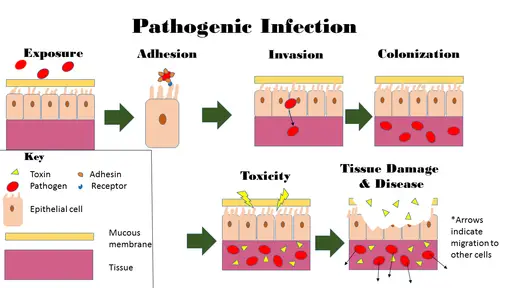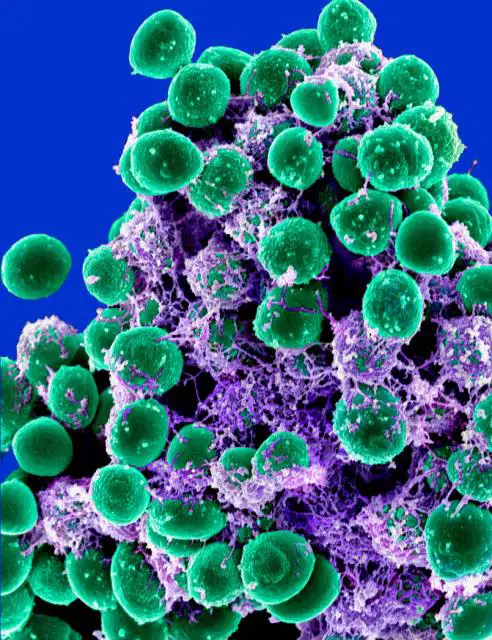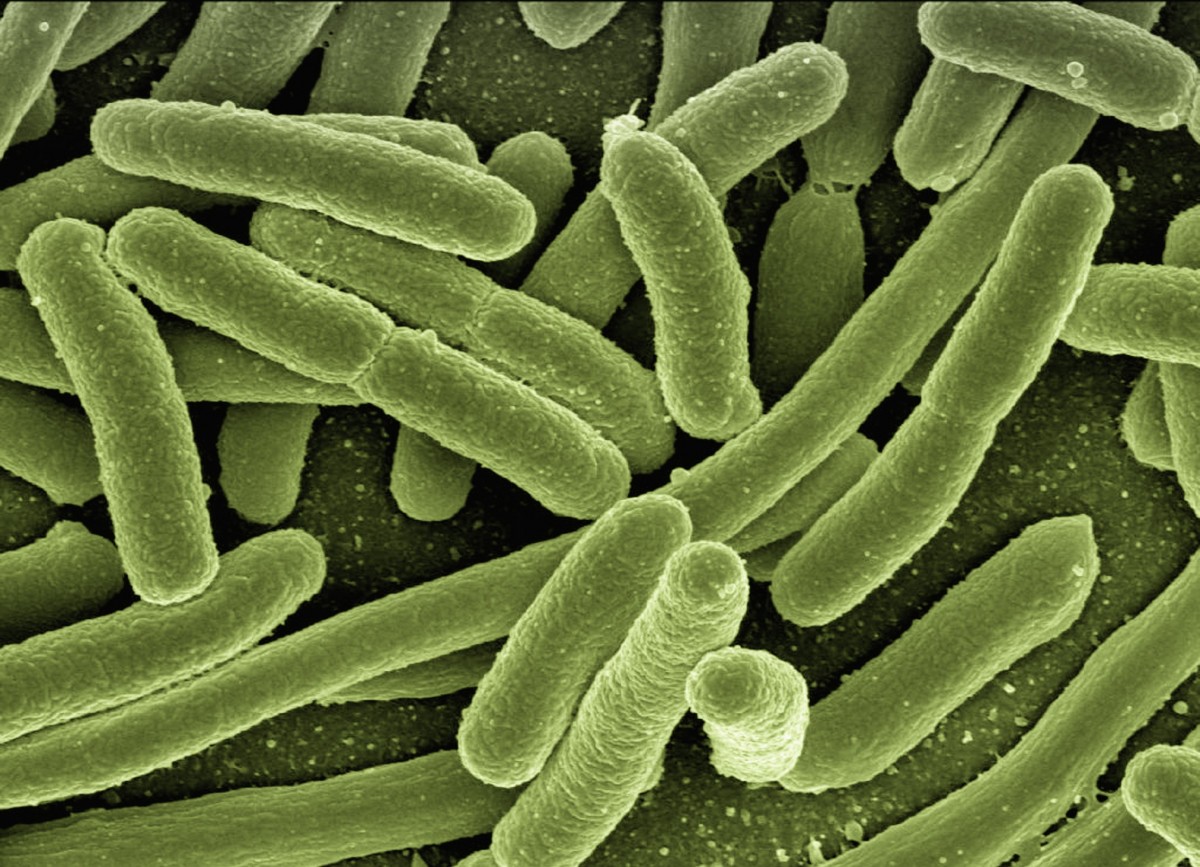How do Bacteria cause Disease?
Bacteria are some of the earliest and most common microorganisms on our planet. Because of their diversity, they can be found in a variety of habits in different environments across the world (from ponds to boiling rivers and desert rocks to name a few).
In nature, some bacteria have been shown to be very important and even essential in some cases (e.g. bacteria that aid in the breakdown of fibers and some starches in the digestive system as well as bacteria involved in decomposition of various materials in the environment etc).
Various bacteria, also, are responsible for a variety of diseases and illnesses in human beings, animals, plants as well as a number of other living organisms. The mechanisms through which they cause these diseases vary from one type of bacteria to another.
However, the severity of the diseases caused by these organisms is also dependent on a number of factors that include:
- Type of bacteria strain and inoculum size
- Part of the body or tissue affected
- Health state of the organisms
- Virulence
- How bacteria gain entry into the body
Before looking at how bacteria actually cause disease, it's important to understand how bacteria actually get into the body. In a normal, healthy organism, there are various important defense mechanisms that play an important role in preventing the entry of bacteria and other microorganisms into the body.
In human beings, for instance, these include the skin, ear wax, the mucus membrane, and acid in the stomach (in plants, these mechanisms may include the waxy cuticle and the bark of the plant, etc).
These are important mechanisms that either act as barriers (e.g. the skin) or trap the bacteria (e.g. e.g. ear wax and mucus membrane) which allows them to be easily removed from the body before they spread any further.
Despite having defense mechanisms that protect the body from bacteria, for the most part, some of the bacteria are able to gain entry and spread to different parts of the body.
The following are some of the means through which different types of bacteria can enter the body:
· Entry through ingestion - Bacteria like Salmonella and Bacillus cereus can enter the body if they are ingested along with contaminated food material or water
· Inhalation - Bacteria like mycobacterium can enter the body through inhalation. A good example of this is when the bacteria is spread from an infected individual through sneezing etc
· Entry through a wound - In a case where part of the skin is wounded, bacteria like C. tetani can easily gain entry into the body However, this may also occur through an insect bite or the use of hypodermic needles etc if care is not taken
· Entry through sexual transmission - Sexual transmission is one of the ways through which sexually transmitted diseases (caused by some bacteria) are spread.
· Entry through devices - Such as pacemakers and catheters etc.
How Bacteria cause Disease in Living Organisms
Cell Damage by Intracellular Bacteria
One of the mechanisms that bacteria use to cause disease is through cell damage. Unlike viruses, which are obligate intracellular pathogens, not all pathogenic bacteria are obligate intracellular pathogens.
Some of the bacteria are intracellular pathogens and therefore have to invade the cell in order to survive and multiply. In order to invade host cells, however, these bacteria have to first enter the body before they can invade the cell.
In the case of bacteria like members of the genus Rickettsia, such vectors as ticks, lice, and fleas play an important role in their transmission to a human host.
Following a bite by one of these vectors, which promotes their entry into the body of the host, Rickettsia bacteria still have to invade the cell, particularly endothelial cells of blood vessels.
To do this, they take advantage of surface adhesion proteins on their surface to attach to proteins (e.g. Ku70) located on the surface of the host cells. This activates a series of events that ultimately cause the cellular membrane to invaginate and form a vesicle around the bacteria.
Once the vesicle is separated from the membrane, it becomes a phagosome that consists of substances that can destroy the bacteria. To avoid this, the bacterium uses the enzyme phospholipase D and tlyc to break the membrane of the phagosome and escape into the cytoplasm.
In the cytoplasm, these bacteria undergo cell division and increase in number. Unlike Rickettsia rickettsii, Rickettsia prowazekii and Rickettsia typhi have been shown to continue multiplying inside the cell causing the cell to burst.
The newly formed cells then invade the neighboring healthy cells and continue causing damage. In the process, they contribute to the damage of blood vessels as the disease continues to progress.
Cell damage by intracellular bacteria has also been observed in a number of diseases including tuberculosis among others. Through cell invasion and cell damage, normal cells, and tissue functions as the bacteria spreads to different parts of the body.
Release of Bacterial Substances/Products by Leukocytes
Following the ingestion of damaged cells by intracellular bacteria along with some bacterial cells, studies have shown these leukocytes to release various substances that can cause damage to the surrounding tissues as is the case with lymphohistiocytic vasculitis.
Here, substances released following phagocytosis as well as activities of the leukocytes cause an increase in permeability of surrounding tissue (e.g. lining of blood vessels) which in turn allows substances to flow into the interstitial space. With increased movement of fluid into the interstitial space, such diseases as edemal hypotension and hypalbuminemia occur.
Using hypotension as an example, bacterial substances released from phagocytosis of the bacteria cause increased permeability of the blood vessels. In this state, fluids move from the vessels to the interstitial space thus reducing the pressure needed to ensure blood is transported to and from different parts of the body.
Under these conditions, an individual is likely to start experiencing dizziness, unusual thirst, lightheadedness, and fainting which is associated with low blood pressure (hypotension).
By Releasing Toxins, Acids, and Enzymes
While some bacteria do not invade cells, they can still cause diseases by releasing a variety of substances that result in diseases.
The following are ways through which these substances cause diseases and illnesses in the host organism:
Toxins
Bacteria toxins are molecules produced by different types of bacteria. In the body of the host, these toxins interfere with normal cell functions/processes resulting in symptoms associated with given bacterial infections. There are different types of bacterial toxins that have a variety of effects on the host cells and tissue.
Some of these toxins include:
Endotoxins (also known as lipopolysaccharides) - Endotoxins are a type of bacteria commonly produced by Gram-negative bacteria.
Unlike some of the other toxins that are secreted and released in their immediate environment, endotoxins are part/components of the bacterial outer membrane (present on the surface of the bacteria). Here, lipid A is the active component of these toxins.
Exotoxins (e.g. botulinum toxin released by C. botulinum) - Exotoxins are a type of toxins that are produced in the extracellular environment by the bacteria.
These toxins are characterized by subunits or structures that allow them to attach to the surface of the host cell so that they can ultimately gain entry through a series of events (e.g. endocytosis).
There are three types of exotoxins that include:
· Toxins Type I - These toxins are released by bacteria like Streptococcus pyogenes and are capable of affecting the host cell without being internalized. A good example of these toxins is the superantigen
· Type III cytotoxins (e.g. toxins secreted by Salmonella bacteria, Shigella bacteria, and Pseudomonas bacteria etc.)- In the case of Type III cytotoxins, toxic molecules are directly injected into the cell through a bacterial structure known as the secretory injection system.
In this case, then, molecules are not simply secreted and released into the extracellular environment, but rather directly introduced into the cell of the host.
· Pore-forming toxins (Toxins Type II) - Like exotoxins, these toxins are secreted in the extracellular space. However, they gradually make their way to the surface of the host cell where they form contact and create pores on the membrane. As a result, they are able to gain entry into the cell of the host.
* In some cases, bacteria produce toxins in response to other bacteria in their surroundings.
Mode of Toxin Action: How Bacteria Toxins cause Disease
There are many types of bacterial toxins that are characterized by different modes of action.
This section will focus on the mode of action of a few toxins to show how they affect normal cell functions and cause diseases:
V. cholerae toxin - V. cholerae toxin is a type of exotoxin produced by the bacteria Vibrio cholerae. Also known as an enterotoxin, the Cholera toxin is an AB toxin which means that it consists of two main subunits (A and B). The "B" subunit of the toxin consists of 5 units and is responsible for attachment to the cell of the host.
On the other hand, the "A" subunit is the active part of the toxin and is associated with the toxic activities. Using the 5 units of the B subunit, the toxin first binds to a glycolipid located on the surface of the cell (cells of the intestinal membrane) known as GM1 (monosialotetrahexosylganglioside). This binding triggers endocytosis which causes the toxin to be internalized into a vesicle and transported to the Endoplasmic Reticulum.
The A subunit (A1 unit of the A subunit) is then released and moves to the cytoplasm. At the cell membrane, the A1 unit interferes with the function of the G protein (associated with Adenylate cyclase). This results in increased molecules of cyclic adenosine monophosphate (cAMP) which in turn stimulate an enzyme known as protein kinase A.
This results in increased release of chloride ions into the extracellular environment followed by movement of water molecules in the same direction thus causing diarrhea. This also allows the bacteria to be released into the environment and the cycle continues.
Lipopolysaccharides - As mentioned, lipopolysaccharides (LPS) is an endotoxin that is located on the surface of Gram-negative bacteria. In the body, with bacteria like S. enterica, the toxin is first released into the extracellular environment in small fragments where they are bound to the Lipopolysaccharide binding protein (LPS-binding proteins).
The resulting complex is important in that it elicits an immune response (macrophages). Following the binding of the complex to CD14 receptors located on the surface of macrophages, and the consequent internalization of the toxin, there are several important outcomes that result in several symptoms.
These include:
Release of interleukin 1 by the cells - This results in increased production of prostaglandin which in turn acts on the hypothalamus to create a response that causes an increase in body temperature (fever)
Increased rate of glycolysis - The toxin has been shown to increase the rate of glycolysis which in turn, causes hypoglycemia (low blood sugar)
Hypotension - Following the internalization of the toxin, production Tumor necrosis factor (TNF) and Nitric oxide (NO) results in hypotension. Here, the two cause vasodilatation (blood vessels dilation) which in turn reduces pressure thus causing hypotension
Bacterial Enzymes
Bacterial enzymes contribute to diseases in a number of ways ranging from eliminating antibodies to causing blood clotting. One of the most important bacterial enzymes is the IgA protease.
Given that pathogen antigens allow the pathogen in question to be eliminated, it's important for some bacteria to find a way to get rid of these antibodies and thus avoid getting destroyed.
One of the main ways this is achieved is through the use of the enzyme IgA protease. Using this enzyme, the bacterium cleaves or removes the IgA antibody from the bacteria thereby making it difficult for the bacteria to be identified.
The other important enzyme produced by bacteria like Clostridium tetani is the enzyme kinase. By breaking down clots, this bacteria cannot be trapped in a given region of the body (e.g. at a cut site). This allows them to be transported to other parts of the body where they can cause disease.
Also, using the enzyme coagulase, some of the bacteria cause clot formation (through the conversion of fibrinogen to fibrin) which protects them from the reach of white blood cells - This promotes the pathogenicity of the bacteria.
* By converting glucose into acids, some bacteria not only cause dental plaque, but can also result in such diseases/conditions as calculus and gingivitis.
How Bacteria cause Disease in Plants
As is the case with animals, bacteria cause disease in plants through the release of toxins as well as enzymes that are capable of causing damage to cells and cell structures. Some bacteria have been shown to colonize various parts of the plants thus interfering with various processes.
Toxins and Enzymes
In plants, toxins produced by various bacteria can affect normal biological processes and result in various abnormalities ranging from necrosis to wilting and chlorosis. However, one of the most important functions of these toxins is to facilitate a successful entry of bacteria into the plant.
To overcome some of the challenges that face bacteria in their attempt to enter the apoplast, studies have shown that a good number of bacteria will produce phytotoxins (e.g. to overcome stomatal immunity).
For instance, through such toxins as coronatine and syringolin, bacteria are able to interfere with such processes as NPR1-dependent salicylic acid (SA) signaling which are involved in plant defense thus allowing the bacteria to thrive without much resistance.
Once they have gained entry into the plant, these toxins also cause significant damage that can result in plant death. For instance, Pseudomonas syringae has been shown to produce syringomycins and syringopeptins which cause necrosis by creating pores on the membrane of plant cells.
Such toxins as mangotoxin and tabtoxin which are produced by P. syringae pathovars cause damage by targeting enzymes involved in amino acid production which in turn results in chlorosis and necrosis.
In addition to toxins, these pathogens also produce various enzymes and other metabolic proteins that promote entry into the plant tissue. Pseudomonas syringae, a rod-shaped, Gram-negative bacterium, is capable of producing such substances as ice nucleating agents that cause frost damage to a variety of plants.
Soft rotting bacteria, on the other hand, produce enzymes that degrade pectin layers that provide structural support to plant cells which can in turn affect the ability of these cells to effectively perform their functions.
* In plant diseases like Lilac shoot blight, caused by Pseudomonas syringae, studies have shown the bacteria to infect healthy tissue and remain dormant during the winter. When temperature increases, the bacteria continue infecting new healthy cells causing lesions and consequently boll loss.
* Such bacteria like Pseudomonas syringae and Xylella fastidiosa can colonize the xylem vessels which affect their functions (water transport) thus causing the plant to wilt and die.
* Proliferation of Agrobacterium tumefaciens at the roots of plants causes mechanical damage to cells which has in turn been associated with Crown gall symptoms.
Some of the other bacteria that cause diseases in plants include:
- Xanthomonas spp
- Phytoplasma spp
- Ralstonia spp
- Pectobacterium spp
- Xylella spp
- Pectobacterium spp
How do Antibiotics kill Bacteria?
Does Salt Water kill Bacteria?
Return to Bacteria under a Microscope
Learning about Bacteria- Size, Shape and Arrangement
List of Diseases caused by Bacteria
Return from How does Bacteria cause Disease? to MicroscopeMaster home
References
Cecilia Hernández-Cortez et al. (2017). Food Poisoning Caused by Bacteria (Food Toxins).
C. Galanos and M. A. Freudenberg. (1993). Bacterial endotoxins: biological properties and mechanisms of action.
Chungyun Bae et al. (2015). Infection processes of xylem-colonizing pathogenic bacteria: possible explanations for the scarcity of qualitative disease resistance genes against them in crops.
Sebastian Pfeilmeier, Delphine L. Caly and Jacob G. Malone. (2016). Bacterial pathogenesis of plants: future challenges from a microbial perspective.
Links
https://www.apsnet.org/edcenter/disandpath/prokaryote/intro/Pages/Bacteria.aspx
Find out how to advertise on MicroscopeMaster!







